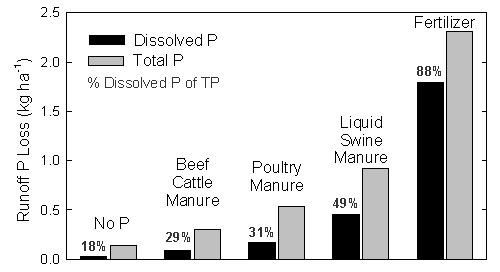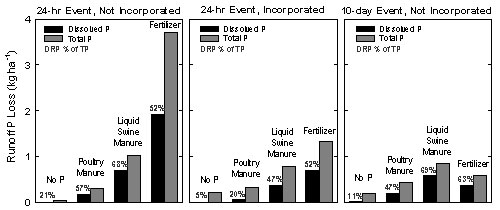You are here
Home ›Phosphorus Transport from Manure

Figure 1. Comparison of phosphorus loss from a rainfall event from fields receiving 100 lb P2O5 per acre from various fertilizer sources including beef cattle manure, poultry manure, liquid swine manure, and DAP fertilizer (figure courtsey of Haq and Mallariono, ISU).

Figure 2. Impact of fertilizer source, runoff timing, and incorporation versus surface application on phosphorus losses in runoff.
This past month has been filled with solid manure applicator trainings. We’ve had the opportunity to have Drs. Antonio Mallarino and Mazhar Haq, ISU agronomy department, present their work on phosphorus management. This presentation was extremely informative with discussions relevant to balancing fertility management and water quality challenges, why transport factors need to be considered along with soil test concentrations, and it had specific information relevant to manure application decisions and phosphorus management. A couple of which we wanted to specifically point out.
Manure is often a heavy point of discussion when it comes to water quality. It’s important to look carefully at what the research says and when we can spread the message of how valuable a resource manure can be for fertility management, and in some cases, how its use helps protect water quality. For example, in one of the studies Drs. Mallarino and Haq presented, they compared phosphorus loss from a field receiving 100 pounds per acre of P2O5 from either beef cattle manure, poultry manure, liquid swine manure, or DAP. A few things to note in all cases, less than 2% of the applied phosphorus was lost in the runoff event, but all the manures, and especially the solid manures, lost substantially less than the DAP fertilizer.
However, as we pick the best days and techniques for manure and fertilizer management, it is important to consider both weather conditions and management practices we can use to reduce phosphorus losses. In a follow up study, they evaluated the impact of runoff event timing and tillage on phosphorus loss from the same fertilizer sources.
In this case, their results showed that if a runoff event was expected, incorporation or injection was strongly recommended to reduce nutrient loss from the DAP and liquid swine manure application, but it had little impact on the poultry manure runoff losses. Timing of the first runoff event was critical. With more time for the phosphorus in the manures to interact with the soil before the first runoff event, it greatly reduced losses.

